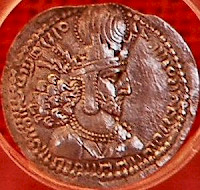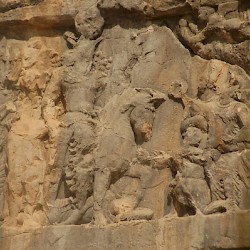This page is a stub. It will be expanded to a full-fledged article.
Shapur I
Shapur I: king of Persia, ruling from 241 to 272, member of the Sasanian dynasty.

Main deeds:
- Name: Shapur I
- As crown prince, Shapur I, appears to have taken Nisibis and Harran in 235 or 236, after the violent death of the Roman emperor Severus Alexander and the accession of Maximinus. Alernatively, this may have happened in 241.
- Beginning of reign: 240 (coregency with his father) or 241
- Successor of: Ardašir I
- 241 The Persian army procedes to the west, and the Roman emperor Gordian III declares war. Unfortunately, there's more that's not been recorded: our sources about this conflict are hopeless, although it is certain that the Romans invaded the Sasanian Empire in 244, recovered Harran and Nisibis,note and were defeated at Misiche. Gordian died under unclear circumstances and the new emperor, Philip, allowed the Sasanians to occupy Armenia.
- However, Armenia was not Philip's to give away: it was an independent kingdom, and its Arsacid kings held out against the Sasanians, who in an inscription on the walls of the Ka'bah-i Zardusht in Naqš-e Rustam blamed Philip, who "had lied about Armenia".
- War with Rome was renewed in 253. Shapur again invaded the Roman Empire, and defeated a large force at Barbalissus. Next year, he recaptured Nisibis and attacked Syria. The Romans found it hard to retaliate, because they were also under attack from the Germanic tribesmen who were later called Visigoths. In the end, however, the emperor Valerian mustered a large army, which was again defeated by Shapur. Valerian was taken captive, and it seemed that Shapur would conquer the now undergarrisoned eastern part of the Roman Empire.
- However, Shapur I now conquered Armenia. Its king Tiridates II left the country and his children sided with the Persians.note The country was ruled by Sasanian princes, first Hormizd I, then Narseh.
- A local leader named Odaenathus of Palmyra restored the Roman border and continued the war. He was immensely successful:, he first recovered Nisibis for the Romans (262), and invaded the Sasanian Empire, even reaching its capital Ctesiphon.note Although he was assassinated in 267 and his wife Zenobia unsuccessfully tried to create an independent empire, in the end, Rome's eastern frontier had been restored.
- End of reign: 272
- Succeeded by: Hormizd I (Ardašir II)
Rock Reliefs
(Numbers according to the Vanden Berghe list.)
- Investiture Naqš-e Rajab
- Equestrian relief Naqš-e Rajab
- Triumph relief Naqš-e Rustam (defeat of Philip and Valerian)
- Triumph relief at Darabgird (defeat of Gordian III, Philip, and Valerian)
- Investiture relief Bishapur (defeat of Gordian III and Philip)
- Triumph relief Bishapur (defeat of Gordian III, Philip, and Valerian)
- Victory relief Bishapur
General Literature on Sasanian Persia
- Touraj Daryaee, Sasanian Persia. The Rise and Fall of an Empire (2009)
- Josef Wiesehöfer, Das antike Persien. Von 550 v. Chr. bis 650 n. Chr. (1994)



